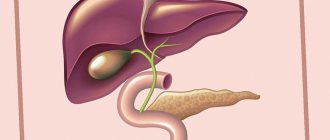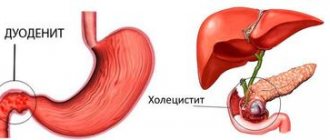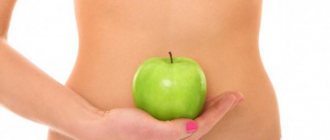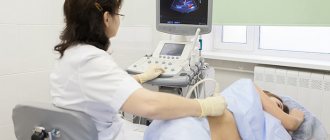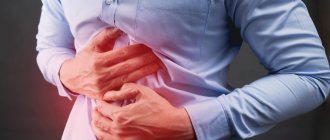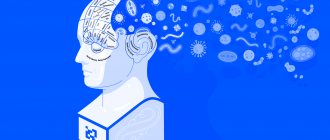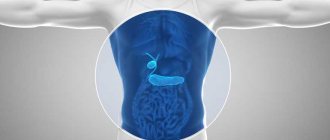What is biliary dyskinesia, how to recognize and diagnose the disease, causes and signs of the disease and why it is dangerous.
“Mom, my stomach hurts!” A child’s complaint causes concern among parents, even if the pain is not severe, appears periodically and passes quickly. One of the reasons for such painful sensations is dysfunction of the biliary tract.
So, we will talk about what the disease is and how dangerous it is.
Norma: how is everything arranged and how it works?
Knowledge will help you understand what is happening.
Bile
Produced by liver cells. It is a liquid containing special substances that are involved in many processes. Without bile, it is impossible to digest fats and move food through the intestines. Bile also helps destroy pathogens.
Biliary tract
Provide transport of bile from the liver to the duodenum. They consist of a system of ducts (elastic tubes) and the gallbladder. The walls of the ducts and bladder have a muscle layer, due to which they can contract. In some places, the walls of the ducts are thickened - these are muscle valves (sphincters).
Bile promotion
When we start to eat, the bladder and its ducts contract, and the sphincters relax and open - bile pours into the duodenum. Then, before the next meal, the gallbladder and its ducts relax and the valves close. A coordinated process is controlled by intestinal hormones and the nervous system.
Treatment of dyskinesia in children
General treatment includes: a special diet, taking vitamins and means to improve liver function (essentiale), mineral water. Drug treatment is determined by the nature of the disorder.
For hypermotor dyskinesia, drugs are used to relax smooth muscles (no-spa, papaverine), sedatives (motherwort, valerian), physiotherapy (electrophoresis, microwave procedures, etc.)
For hypomotor dyskinesia, drugs that stimulate the production of bile (allochol, flamin) and gastrointestinal motility (metoclopramide), and tubages are used.
Reasons: where to expect a catch?
Under the influence of various factors, the gallbladder and its ducts can contract excessively or, on the contrary, insufficiently.
Primary dyskinesia
The organs of the digestive system function normally and are healthy, but certain factors can interfere with the coordinated contraction and relaxation of the biliary tract.
* Dietary disorders: snacking, poor chewing, overeating, eating fatty/spicy foods, etc.
* Psychogenic factors (stress, neuroses, negative emotions) and damage to the nervous system (consequences of hypoxia, convulsive syndrome, etc.).
* Allergies: allergic skin lesions (rash, itching, etc.), food allergies (very common), bronchial asthma, etc.
Secondary dyskinesias
They occur when there are initially some diseases or changes in the organ.
* Anatomical features (septum/kink of the gallbladder) become the causes of bile stagnation.
* Worms (giardiasis, opisthorchiasis). While in the gallbladder, parasites disrupt the flow of bile and irritate the nerve endings.
* Intestinal infections and lesions of the digestive system: (pancreatitis, cholecystitis, gastritis, hepatitis, ulcers, etc.). May disrupt the formation of intestinal hormones.
- Gallery
- Reviews
- Articles
- Licenses
- Vacancies
- Insurance partners
- Partners
- Controlling organizations
- Schedule for receiving citizens for personal requests
- Online consultation with a doctor
- Documentation
Biliary dyskinesia (BDT) is a functional disorder of the timely and complete outflow of produced bile into the duodenum.
For dyskinesias of the gallbladder:
- there is a change in the movement of bile along the bile ducts;
- the process of food digestion is disrupted;
- the synthesis of vitamins and absorption of nutrients decreases, which can lead to a delay in the psycho-motor development of the child;
- the secretion of bile is disrupted, which contributes to the growth of opportunistic microflora in the intestine;
- it is possible to form functional disorders in the respiratory organs, heart and blood vessels, nervous system and others.
An important role in the development of primary dyskinesia is played by dietary disturbances:
- long breaks in nutrition;
- binge eating;
- force feeding;
- consuming excess fatty or spicy foods.
Such forms of dyskinesia of the gastrointestinal tract often occur in children with neuroses, vegetative-vascular dystonia, psychosomatic syndrome or neuro-arthritic abnormality of the constitution.
Secondary dyskinesias arise as complications of pathological processes in the digestive organs when:
- chronic cholangitis (inflammation of the bile ducts);
- chronic duodenitis (inflammation of the duodenum);
- chronic enterocolitis (inflammation of the small and large intestines);
- intestinal infections (salmonellosis, dysentery, acute hepatitis);
- helminthic lesions.
The development of biliary dyskinesia is particularly affected by intestinal giardiasis. Parasites damage the mucous membrane of the duodenum, cause dystrophic phenomena and disrupt the production of intestinal hormones. As a result, the coordination of the intestinal sphincters and sphincters in the area of the biliary system is disrupted.
There are three clinical forms of gastric dyskinesia in children:
- hypomotor
- hypermotor
- mixed.
With hypomotor dyskinesia of the gallbladder, the gallbladder contracts sluggishly. I am concerned about dull, aching pain in the right side, radiating to the right shoulder blade and collarbone, a feeling of fullness, heaviness, and discomfort.
For children with a hypomotor form of dyskinesia, gastric dyskinesia is characterized by:
- constipation;
- nausea;
- vomit;
- belching;
- bitterness in the mouth;
- lack of appetite;
- headache;
- dizziness;
- weakness.
Hypermotor dyskinesia of the gallbladder occurs with spastic contraction of the gallbladder. Characterized by colicky or cramping pain in the right side after eating, radiating to the right shoulder blade, collarbone, lower back or epigastric region.
The pain intensifies with:
- fast running, walking (usually in physical education lessons);
- in stressful situations (a burning sensation along the intestines after excitement) and in case of diet disorders (after sweets);
- frequent loose stools;
- the tongue is covered with a yellow coating;
- Nausea, belching and vomiting are possible.
Patients with this form cannot tolerate fatty foods, fried foods, or egg yolks.
The mixed form of dyskinesia of the gastrointestinal tract combines signs of hypo- and hypermotor forms.
The simplest and most modern method for studying gallbladder dyskinesia is ultrasound - it allows you to determine the shape, size and possible deformations of the gallbladder, stones in its body and ducts. The examination is absolutely painless and does not cause any discomfort. To clarify the type of dyskinesia, a functional test is additionally performed.
The children's clinic of the Literary Fund uses an expert-class ultrasound machine “TOSHIBA XARIO” with a set of multi-frequency sensors, color Doppler and energy mapping. Doctors with the highest qualification category work.
Based on complaints, examination of the child, ultrasound examination of the abdominal cavity and other data (clinical and biochemical blood tests, coprogram, examination for parasitic infections, etc.), a pediatric gastroenterologist makes a conclusion about the presence or absence of dyskinesia. Depending on the form, appropriate treatment is prescribed.
Untreated dyskinesia of the gallbladder can be complicated by chronic cholecystitis, cholelithiasis, and pancreatitis.
Services and prices
Primary appointment (examination, consultation) with a gastroenterologist
2,200 rub.
Repeated appointment (examination, consultation) with a gastroenterologist
2,100 rub.
Carrying out a breath test for Helicobacter pylori infection using the Helik test system
810 rub.
Ultrasound examination of the gallbladder with determination of its contractility
2,000 rub.
Ultrasound examination of the gallbladder
1,400 rub.
Make an appointment
Signs of biliary dysfunction: what to look for?
Based on the type of violation, there are three possible course options.
Hypertensive type
The tone of the ducts and bladder is increased, bile quickly and often enters the intestines.
How it manifests itself
pain , usually in the form of colic, occurs on the right side of the upper abdomen. In young children, pain may occur around the navel or throughout the abdomen. The appearance of pain is caused by stress (most often), physical activity or dietary errors. An attack of colic usually lasts up to half an hour, then the pain subsides and reappears after a while.
Bitterness in the mouth in the morning or after eating is a common companion to dyskinesia.
During an attack, children often feel sick or vomit. After an attack or eating, loose stools .
Hypotonic type
The tone of the bladder and ducts is reduced (pathways are relaxed). Bile enters the intestines rarely, slowly and in insufficient quantities.
How it manifests itself
The pain is located in the right hypochondrium. It is aching or bursting in nature, but often children cannot describe what they feel. The pain persists constantly, intensifying during or immediately after eating.
Sometimes a child complains of nausea or vomiting after eating or if there is a malnutrition . There may be a bitter taste in the mouth. Constipation is common .
Mixed form
There are signs of both hypertensive and hypotonic types of dyskinesia.
On a note!
An older child usually tells adults about his poor health. However, due to his age, the baby cannot do this, so if the baby periodically, seemingly for no reason, is capricious and/or eats poorly, consult a doctor.
Prevention
Preventive measures that help prevent the occurrence of the disease:
- compliance with the work and rest regime;
- a complete balanced diet with a limit on fried, fatty foods, smoked foods, salty foods and the inclusion of fresh vegetables and fruits;
- quitting smoking and other bad habits;
- dosing of physical activity;
- good sleep, regular walks in the fresh air;
- timely treatment of pathologies (both acute and chronic);
- exclusion of stressful, traumatic situations.
It is worth highlighting separately secondary prevention, which is indicated after diagnosing the pathological process in the patient. It consists of conducting regular preventive examinations to identify characteristic signs of the disease at the earliest stages.
Despite the fact that the pathology is chronic, if the measures listed above are observed, the disease will proceed without exacerbations. If you refuse to take preventive measures, serious complications from the liver, gallbladder, and bile ducts are possible.
Diagnostics
Conventional methods (ultrasound, blood tests) do not help to identify the disease, since with bile ducts, the bile ducts work normally at rest.
In children, ultrasound with stress is of diagnostic value. The first study is carried out in the morning on an empty stomach, but most often it is not informative. The second is after breakfast (for example, you can take a sandwich with you). Then an ultrasound reveals a violation of the motor activity of the biliary tract.
How to distinguish dyskinesia from poisoning and intestinal infection?
Some dangerous diseases can masquerade as symptoms of ADHD. Let's figure out how these conditions differ.
| Symptom | JVP | Food poisoning/intestinal infection |
| First signs | Usually they increase gradually or there is a light interval between attacks. | They appear in a healthy child and within a few hours his condition worsens. There is often a relationship with the consumption of poor-quality food or the presence of patients with intestinal infection in the child’s environment. |
| Stomach ache | Paroxysmal and strong - with the hypertensive type. Dull and aching, worse after eating - with the hypotonic type. | The entire abdomen or upper part (stomach area) hurts. Small children show pain around the navel. |
| Nausea/ vomit | Appear during or immediately after eating. | Nausea almost constantly. Vomiting is repeated and profuse. They occur regardless of food intake, but may intensify after eating and drinking. |
| Appetite | Reduced or normal. | The child is bad or refuses to eat at all. |
| Chair | Hypotonic type - constipation. Hypertensive type - diarrhea that occurs immediately after eating or during an attack. | Frequent, does not depend on food intake. It can be watery or foamy. May contain particles of undigested food, mucus or blood (rarely). The color changes: it can be yellow, greenish. |
| Loss of consciousness | No. | Possibly in serious condition. |
| Body temperature | Normal. | It increases from the first hours of illness. |
| Dehydration (dry skin, baby losing weight) | No. | Due to vomiting and diarrhea it increases rapidly. |
Question answer
Women get sick 10 times more often than men.
The primary type most often occurs in individuals with autonomic dysfunctions, nervous disorders, poor diet and sleep disorders. Secondary pathology develops against the background of diseases of the digestive system, hepatitis, after removal of the gallbladder. The likelihood of getting sick is influenced by hormonal levels and the presence of certain chronic diseases in the anamnesis.
If treated incorrectly, the risk of gallstones formation, acute or chronic pancreatitis, cholecystitis, and reflux gastritis increases. All this is difficult to treat and seriously affects the patient’s health.
